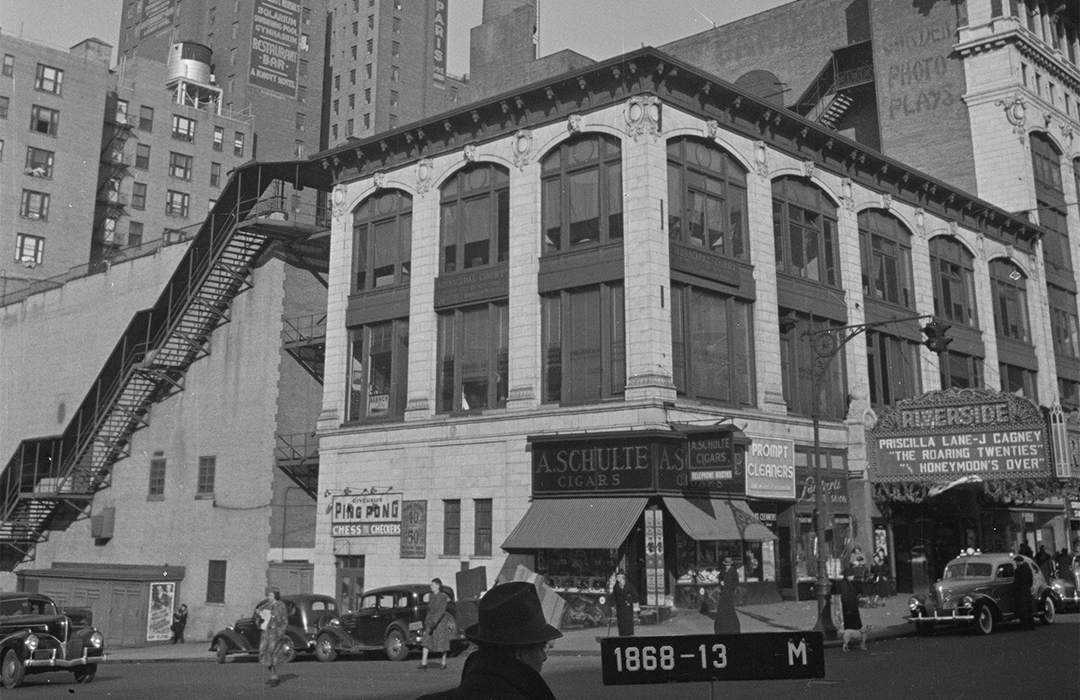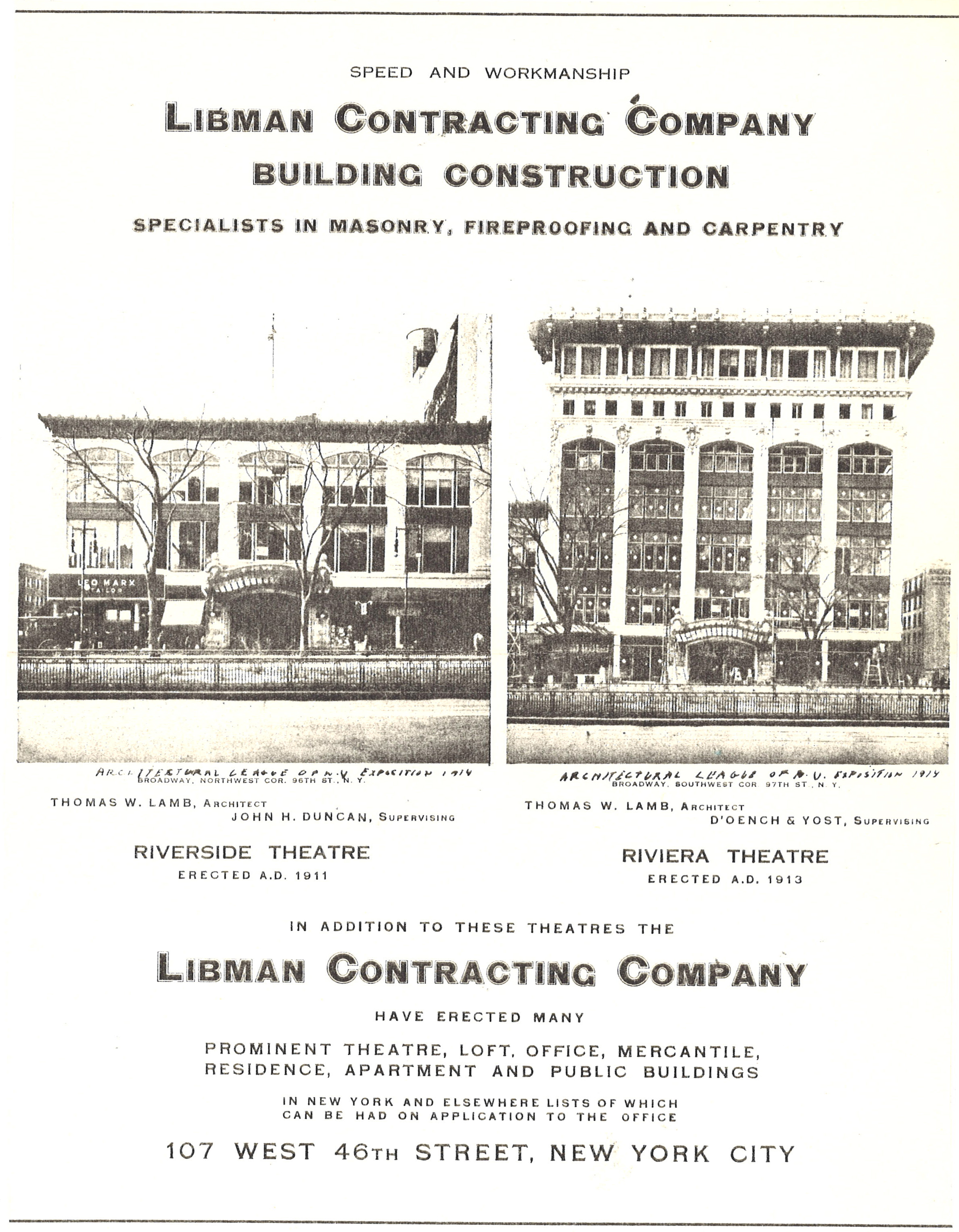
The Riverside Theater
by Tom Miller
In 1909 pioneering motion picture executive William Fox gave architect Thomas W. Lamb his first commission to design a “picture playhouse,” or motion picture theater. The two men would repeatedly work together, and Lamb would eventually become the foremost motion picture theater designer in America. In April 1911 Lamb was simultaneously working on six theater designs, one of which, the three-story Riverside Theatre at the northwest corner of Broadway and 96th Street, was for William Fox.
Costing $200,000 to construct—or about $5.8 million in 2023 money—the Riverside Theatre was clad in white terra cotta, the upper floor openings nestled in cast iron frames within double-height elliptical arches. Stores flanked the theater entrance.
The Riverside Theatre’s auditorium was available for public meetings during the rare times motion pictures were not playing. An example was the “mass meeting” called by Joseph S. Schwab on May 18, 1914. Schwab was president of the Real Estate Owners’ Protective association, and the purpose of the meeting was to push for “a subway line along Central Park West north of Fifty-ninth Street,” as reported by The New York Times.
Justice Putnam lifted the injunction, saying “the original agreement never should have been made.”
A somewhat surprising Fox motion picture premiered here on September 30, 1911–a silent screen adaptation of the opera Carmen, starring Theda Bara. The New York Times critic said Bara was “a movie star who is widely known as ‘the vampire woman’ of the screen and who is immensely popular in the theaters where her pictures are shown.” Nevertheless, he felt she fell short in this role. “Miss Bara seems very mechanically seductive when compared, as she must be, with [opera star] Geraldine Farrar.” A month later another Theda Bara film was playing at the Riverside Theatre. The Galley Slave was based on the stage play of the same name by Bartley Campbell.
On November 17, 1916, The New York Times reported that William Fox had leased the Riverside Theatre to B. F. Keith Enterprises. (By now Fox had another, larger theater, the Riviera, right next door.) Keith ran a chain of vaudeville theaters and the change in the Riverside’s offerings did not sit well with the Hammerstein Amusement Company, which operated vaudeville theaters.
Within the month the rival firm sued B. F. Keith Enterprises. On December 20, The New York Times reported that it had applied “for a permanent injunction to restrain B. F. Keith…from opening the Riverside Theatre, at Broadway and Ninety-sixth Street, as a vaudeville playhouse.” The Hammerstein Company claimed it had exclusive rights to stage vaudeville on the Upper West Side. In 1908 the “high-class vaudeville” managers, said Hammerstein, had agreed to divvy up Manhattan into districts. Finally, on February 9, 1917, B. F. Keith Enterprises emerged victorious. Justice Putnam lifted the injunction, saying “the original agreement never should have been made.”
Among the first vaudevillians to appear here was John H. Coogan, in 1917. Backstage was his 20-month-old son, Jackie. While Coogan was in the middle of his act, according to The New York Times, the little boy “toddled out upon the stage. The father saved the situation by having the child join him in a dance step.” The accidental introduction to the entertainment world resulted in Charlie Chaplin’s casting Jackie Coogan as “The Kid” in a series of silent movies and creating a child star. (Jackie Coogan is best remembered to today’s generation as Uncle Fester in the television Series, The Addams Family.)
The management scored a coup the following year. On January 8, 1918, The Sun reported that Sarah Bernardt was appearing at the Riverside Theatre that week in the play From the Theatre to the field of Honor. Sharing the bill were several other acts “interspersed in the choice entertainment.”
Some of the entertainers who had abandoned vaudeville for motion pictures returned to their familiar territory. In February 1919 Mme. Olga Petrova opened at the Riverside Theatre after working in films for four years. The New-York Tribune reported, “She sang, among other things, ‘My Hero,’ and sang it in four octaves…She sang a parrot song, too, which sounded for all the world like poor Poll. And then she gave a scene from one of her plays, where she chokes herself to death in a struggle supposedly with a jilted lover.”
The accidental introduction to the entertainment world resulted in Charlie Chaplin’s casting Jackie Coogan as “The Kid” in a series of silent movies and creating a child star.
And on December 9, 1923, The Morning Telegraph reported, “Theodore Roberts, erstwhile member of the stage and for the past several years connected only with the picture world, has made one of the outstanding successes in vaudeville this season. His act at the Riverside Theatre during the past week has been the case of much talk, and all in favor of Mr. Roberts.”
In 1929 the Riverside Theatre was leased to the newly formed R. K. O. Pictures. The New York Times reported on January 8, 1930, “Short screen subjects and sound new reels will be added to the vaudeville programs at the R. K. O. Riverside Theatre…Under the new policy two performances will be given daily from Monday through Saturday, with a continuous performance on Sunday, starting at 12:45 P.M.”
The Riverside Theatre continued to draw crowds through the Depression and beyond. In February 1942, the 20th Century Fox film noir I Wake Up Screaming, starring Betty Grable, Victor Mature and Carole Landis opened. And by 1970 the venue was the United Artists Riverside (the company owned the Riviera next door, as well).
Both of the vintage Thomas W. Lamb structures were demolished in 1976, to be replaced by a 31-floor apartment building.
Tom Miller is a social historian and blogger at daytoninmanhattan.blogspot.com
BUILDING DATABASE
Keep Exploring
Be a part of history!
Think Local First to support the businesses at 2561-2569 Broadway:



